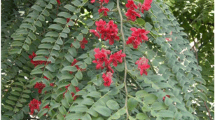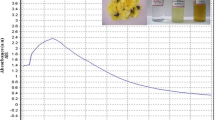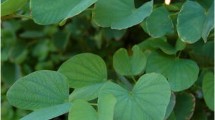Abstract
Mosquitoes and mosquito-borne diseases are prone to raise health and economic impacts. Synthetic insecticide-based interventions are indeed in situations of epidemic outbreak and sudden increases of adult mosquitoes. Nanoparticles are being used in many commercial applications and were found that aqueous silver ions can be reduced by an aqueous extract of plant parts to generate extremely stable silver nanoparticles in water. Based on this, silver nanoparticles (SNPs) were synthesized using leaf aqueous extract (LAE) of Mukia maderaspatana. Further, the synthesized SNPs were characterized by UV–visible spectrum, which indicated a strong plasmon resonance at 427 nm. X-ray diffraction (XRD) analysis revealed the average crystalline size of the synthesized SNPs was approximately 64 nm by Debye–Scherrer formulae. Fourier transform infrared (FTIR) spectroscopy analysis revealed the presence of different functional groups like amines, halides, alkanes, alkynes, amides, and esters with respective stretches, which are responsible for the bio-reduction of silver ions. Field emission scanning electron microscopy (FESEM) depicted the spherical morphology of SNPs with size range of 13–34 nm. The larvicidal activity of LAE and SNPs exhibited an effective mortality to Aedes aegypti and Culex quinquefasciatus. The lethal concentration (LC50; LC90) of LAE and SNPs were found to be 0.506; 1.082, 0.392; 0.870 ppm and 0.211; 0.703, 0.094; 0.482 ppm, respectively on A. aegypti and C. quinquefasciatus. Thus, the synthesized SNPs have shown preponderant larvicidal activity, but further studies are needed to formulate the potential larvicidal agents.






Similar content being viewed by others
References
Abdul Rahuman A, Gopalakrishnan G, Venkatesan P, Geetha K (2008) Larvicidal activity of some Euphorbiaceae plant extracts against Aedes aegypti and Culex quinquefasciatus (Diptera: Culicidae). Parasitol Res 102:867–873
Arockiya ARF, Parthiban C, Ganesh Kumar V, Anantharaman P (2012) Biosynthesis of antibacterial gold nanoparticles using brown alga, Stoechospermum marginatum. Spectro Acta A 99(1):166–173
Bagavan A, Abdul Rahuman A, Kamaraj C, Geetha K (2008) Larvicidal activity of saponin from Achyranthes aspera against Aedes aegypti and Culex quinquefasciatus (Diptera: Culicidae). Parasitol Res 103:223–229
Chandran SP, Chaudhary M, Pasricha R, Ahmad A, Sastry M (2006) Synthesis of gold nanotriangles and silver nanoparticles using Aloe vera plant extract. Biotech Prog 22(2):577–583
Choi O, Deng KK, Kim NJ, Rose L Jr, Surampalli RY, Hu Z (2008) The inhibitory effects of silver nanoparticles, silver ions and silver chloride colloids on microbial growth. Water Res 42:3066–3074
Corbel V, Nosten F, Thanispong K, Luxemburger C, Kongmee M, Chareonviriyaphap T (2013) Challenges and prospects for dengue and malaria control in Thailand, Southeast Asia. Trends Parasitol 29:623–633. doi:10.1016/j.pt.2013.09.007
Finney DJ (1971) Probit analysis, vol 551. Cambridge University Press, London, pp 68–72
Hackenberg S, Scherzed A, Kessler M, Froelich K, Ginzkey C, Koehler C, Burghartz M, Hagen R, Kleinsasser N (2010) Zinc oxide nanoparticles induce photocatalytic cell death in human head and neck squamous cell carcinoma cell lines in vitro. Int J Oncol 37:1583–1590
Hussein ASM, Kingston DGI (1982) Screening of plants used in Sudan folk medicine for anticancer activity (II). Fitoterapia 53:119
Jayaseelan C, Abdul Rahuman A, Rajakumar G, Vishnu Kirthi A, Santhoshkumar T, Marimuthu S, Bagavan A, Kamaraj C, Abduz Zahir A, Elango G (2011) Synthesis of pediculocidal and larvicidal silver nanoparticles by leaf extract from heartleaf moonseed plant, Tinospora cordifolia Miers. Parasitol Res 109:185–194
Jayaweera DMA (1982) Medicinal plants used in Ceylon. National Science Council, Sri Lanka Publication, Colombo, pp 147–153
Kamaraj C, Abdul Rahuman A, Bagavan A (2008) Antifeedant and larvicidal effects of plant extracts against Spodoptera litura (F.), Aedes aegypti L. and Culex quinquefasciatus Say. Parasitol Res 103:325–331
Kotakadi VS, Rao YS, Gaddam SA, Prasad TNVKV, Varada Reddy A, Sai Gopala DVR (2013) Simple and rapid biosynthesis of stable silver nanoparticles using dried leaves of Catharanthus roseus. Linn. G. Donn and its antimicrobial activity. Colloids Surf B 105:194–198
Kreuter J, Gelperina S (2008) Use of nanoparticles for cerebral cancer. Tumori 94:271–277
Kunkel G (1984) Plants for Human Consumption. Koeltz Scientific Books, pp 393
Mubayi A, Chatterji S, Rai PM, Watal G (2012) Evidence based green synthesis of nanoparticles. Adv Mat Lett 3(6):519–525
Mulvaney P (1996) Surface plasmon spectroscopy of nanosized metal particles. Langmuir 12(3):788–800
Oberdorster G, Oberdorster E, Oberdorster J (2005) Nanotoxicology: an emerging discipline evolving from studies of ultrafine particles. Environ Health Perspect 113:823–839
Patil CD, Patil SV, Borase HP, Salunke BK, Salunkhe RB (2012) Larvicidal activity of silver nanoparticles synthesized using Plumeria rubra plant latex against Aedes aegypti and Anopheles stephensi. Parasitol Res 110:1815–1822
Petrus AJA (2012) Mukia maderaspatana (Linn.) M. Roemer: a potentially antidiabetic and vasoprotective functional leafy-vegetable. Pharmacogn J 4(34):1–12
Philip D, Unni C (2011) Extracellular biosynthesis of gold and silver nanoparticles using Krishna tulsi (Ocimum sanctum) leaf. Phys E 43(7):1318–1322
Prabakar K, Sivalingam P, Rabeek SIM, Muthuselvam M, Devarajan N, Arjunan A, Karthick R, Suresh MM, Wembonyam JP (2013) Evaluation of antibacterial efficacy of phyto fabricated silver nanoparticles using Mukia scabrella (Musumusukkai) against drug resistance nosocomial gram negative bacterial pathogens. Colloids Surf B: Biointerfaces 104:282–288
Raja B, Pugalendi KV (2009) Evaluation of antioxidant activity of Melothria maderaspatana in-vitro. Cent Eur J Biol 5(2):224–230
Raju K, Jambulingam P, Sabesan S, Vanmail P (2010) Lymphatic filariasis in India: epidemiology and control measures. J Postgrad Med 56:232–238
Ramakrishanamacharya CH, Krishnaswamy MR, Bhima RR, Viswanathan S (1996) Anti-inflammatory efficacy of Melothria in active rheumatoid arthritis. Clin Rheumatol 15:214–215
Sankar R, Karthik A, Prabu A, Karthik S, Shivashangari KS, Ravikumar V (2013) Origanum vulgare mediated biosynthesis of silver nanoparticles for its antibacterial and anticancer activity. Colloids Surf B: Biointerfaces 108:80–84
Sap-Iam N, Homklinchan C, Larpudomlert R, Warisnoicharoen W, Sereemaspun A, Dubas ST (2010) UV irradiation induced silver nanoparticles as mosquito larvicides. J Appl Sci 10(23):3132–3136
Sen-Sung C, Hui-Ting C, Shang-Tzen C, Kum-Hsien T, Wei-June C (2003) Bioactivity of selected plant essential oils against the yellow fever mosquito Aedes aegypti larvae. Biores Technol 89:99–102
Spatz JP, Herzog T, Momer S, Ziemann P, Muller M (1999) Micellar inorganic–polymer hybrid systems-a tool for nanolithography. Adv Mater 11(2):149–153
Sriram MI, Kanth SB, Kalishwaralal K, Gurunathan S (2010) Antitumor activity of silver nanoparticles in Dalton’s lymphoma ascites tumor model. Int J Nanomedicine 5:753–762
Su J, Zhang J, Liu L, Huang Y, Mason RP (2008) Exploring feasibility of multicolored CdTe quantum dots for in vitro and in vivo fluorescent imaging. J Nanosci Nanotechnol 8:1174–1177
Subarani S, Sabhanayakam S, Kamaraj C (2013) Studies on the impact of biosynthesized silver nanoparticles (AgNPs) in relation to malaria and filariasis vector control against Anopheles stephensi Liston and Culex quinquefasciatus Say (Diptera: Culicidae). Parasitol Res 112:487–499
Suresh AK, Doktycz MJ, Wang W, Moon JW, Gu B, Meyer HM III, Hensley DK, Allison DP, Phelps TJ, Pelletier DA (2011) Monodispersed biocompatible silver sulfide nanoparticles: Facile extracellular biosynthesis using the γ-proteobacterium, Shewanella oneidensis. Acta Biomater 7:4253–4258
Tan WB, Jiang S, Zhang Y (2007) Quantum-dot based nanoparticles for targeted silencing of HER2/neu gene via RNA interference. Biomaterials 28:1565–1571
Thomas TG, Rao S, Lal S (2004) Mosquito larvicidal properties of essential oil of indigenous plant Ipomoea cairica Linn. Jpn J Infect Dis 57:176–177
Tripathi A, Chandrasekaran N, Raichur AM, Mukherjee A (2009) Antibacterial applications of silver nanoparticles synthesized by aqueous extract of Azadirachta indica (Neem) leaves. J Biomed Nanotechnol 5(1):93–98
Vivekanandhan S, Misra M, Mohanty AK (2009) Biological synthesis of silver nanoparticles using Glycine max (soybean) leaf extract: an investigation on different soybean varieties. J Nanosci Nanotechnol 9(12):6828–6833
West JL, Halas NJ (2000) Applications of nanotechnology to biotechnology. Curr Opine Biotech 11:215
World Health Organization (1981) Instructions for determining the susceptibility or resistance of mosquito larvae to insecticides. WHO/VBC 81:807–962
World Health Organization (2014) World malaria report 2013. Geneva: WHO, 2014. http://www.who.int/malaria/publications/world_malaria_report_2013/en/index.html accessed 26 February 2014
Yoon K, Byeon J, Parl J, Hwang J (2007) Susceptibility constants of Escherichia coli and Bacillus subtilis to silver and copper nanoparticles. Sci Tot Env 373:572–575
Zandonella C (2003) Cell nanotechnology: the tiny toolkit. Nature 423:10–12
Zhang H, Hussain I, Brust M, Cooper AI (2004) Emulsion-templated gold beads using gold nanoparticles as building blocks. Adv Mater 16(1):16–30
Zhang Y, Yang M, Portney NG, Cui D, Budak G, Ozbay E, Ozkan M, Ozkan CS (2008) Zeta potential: a surface electrical characteristic to probe the interaction of nanoparticles with normal and cancer human breast epithelial cells. Biomed Microdevices 10:321–328
Acknowledgments
The authors are grateful to the authorities of Periyar University for providing the necessary facilities to carry out this work.
Author information
Authors and Affiliations
Corresponding author
Rights and permissions
About this article
Cite this article
Chitra, G., Balasubramani, G., Ramkumar, R. et al. Mukia maderaspatana (Cucurbitaceae) extract-mediated synthesis of silver nanoparticles to control Culex quinquefasciatus and Aedes aegypti (Diptera: Culicidae). Parasitol Res 114, 1407–1415 (2015). https://doi.org/10.1007/s00436-015-4320-7
Received:
Accepted:
Published:
Issue Date:
DOI: https://doi.org/10.1007/s00436-015-4320-7




